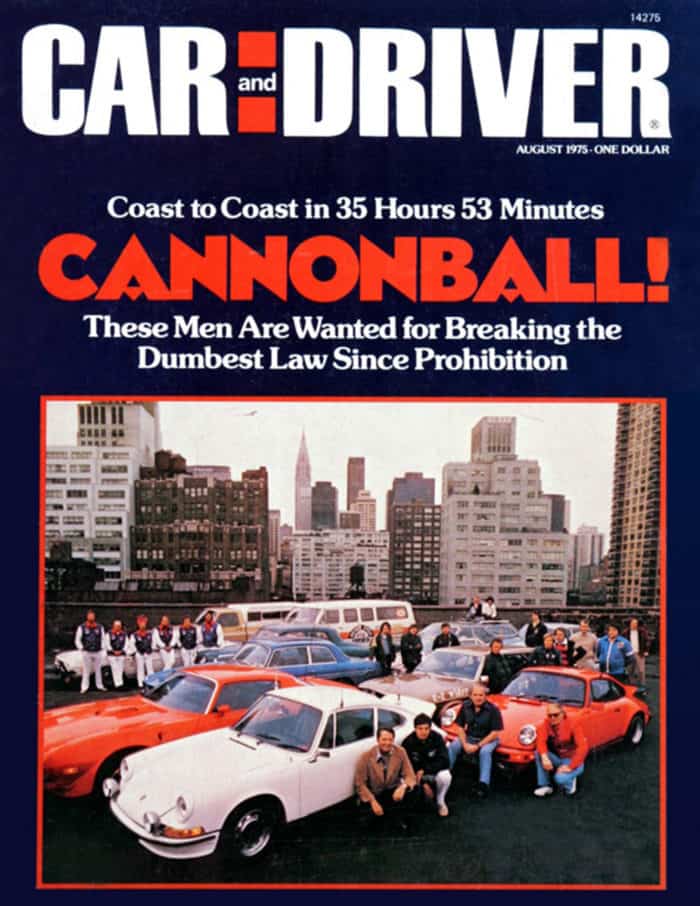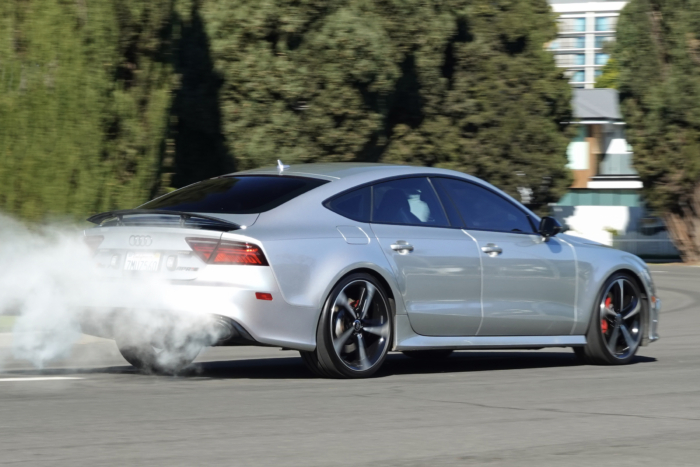(This article has been updated consistently since its publication in 2021 to reflect the latest records and information available. We will continue to stay on top of all things Cannonball.)
The Cannonball Run is an unparalleled street race with one goal: Drive from New York to California in the shortest amount of time. Let’s dive into all things Cannonball and look into the Cannonball Run record books.
- Cannonball Run Record: 25 hours and 39 minutes by Arne Toman and Doug Tabbutt in a 2016 Audi S6 in May 2020
- Coast-to-Coast-to-Coast Cannonball Run Record: 61 hours and 59 minutes by Nik Krueger, Wesley Vigh, and Christopher Michaels in a 2008 Saab 9-5 Aero
- Solo Cannonball Run Record: 27 hours and 16 minutes by Chris Stowell in a 2015 BMW 535d on August 25-26, 2024 (also the Diesel and Non-COVID records)
- Motorcycle Cannonball Run Record: 32 hours and 32 minutes by Ross “Beau” Earnest aboard a 2008 Yamaha FJR1300 on April 21, 2024
- EV Cannonball Run Record: 42 hours and 17 minutes by Ryan Levenson and Josh Allan in a rented Tesla Model S Long Range in October 2021
Cannonball Run
When you first hear of an illegal and unsanctioned race across the entire United States, perhaps chaos and carelessness come to mind. Maybe you’ve even seen the 1981 film, “The Cannonball Run” which fictionally showcases the drive with the “All-American” glitz and recklessness of street racing. Although the race is illegal, it is anything but chaotic or careless.
The reality is that the racers of the Cannonball Run are usually methodical, attentive, and diligent, which is perhaps even more baffling. Brock Yates, who created the race in the 1970s, wanted to prove that you could “drive quickly across the country in normal traffic without disrupting anyone or being unsafe.”
The run traditionally begins at the Red Ball Garage in Manhattan, New York, and ends at the Portofino Hotel & Marina in Redondo Beach, Calif. To this day, there are only a few people both crazy and determined enough to attempt the coast-to-coast run, especially with the goal of a new Cannonball record.
At the beginning of the 2019 documentary, “APEX: The Secret Race Across America” which covers the true story of how the Cannonball Run record was broken in 2006, the audience is posed with three questions: “What could be more pointless? What could be more dangerous? What were these people thinking?”
The end of “APEX” doesn’t provide any answers, but, instead, leaves the audience with even more questions: “Why did Cannonball Baker do it? Why did Alex [Roy] and David [Maher] do it? Were they chasing something?”
In the end, the documentary doesn’t attempt to untangle the complexities of the 110 years of the Cannonball Run, simply stating, “Those questions can’t be answered.”
Coast-to-Coast Racing
In this Cannonball Run article, you will find a complete history and rundown of all the records, and a list of movies and books about the run.

History of the Cannonball Run
Let’s talk about the history of this race that spans from 1903 to now — how this race came to be and how it withstood the test of time, scrutiny, and well, the law. In an interesting twist, in order to avoid legal ramifications, all information of the individuals who set the new records are often not released until at least a year after the fact, once the statute of limitations has expired.
Paving the Road for the Cannonball Run
The first cross-country drive, from San Francisco to New York City, was completed in 1903 by George Adams Wyman on a 1902 California Motor Company motor bicycle. The trip, which covered 3,800 miles and took 51 days, concluded on July 6, 1903.
At the exact same time, H. Nelson Jackson and his mechanic Sewall Crocker, were the first to cross the continent by automobile, in a 1903 Winton touring car. They started their trip earlier than Wyman, but completed it after him, taking 64 days to complete the journey.

Erwin George “Cannon Ball” Baker

53:30 — An Unofficial Record That Stood for 38 Years
The First ‘Official’ Unsanctioned Races: Brock Yates & the Cannonball Baker Sea-to-Shining-Sea Memorial Trophy Dash
A Day to Remember: November 15, 1971

1972 & 1975 Cannonball Baker Sea-to-Shining-Sea Memorial Trophy Dash

‘Final’ Cannonball Run in 1979
Cannonball Run Under a New Name: The U.S. Express

Inaugural 1980 U.S. Express

1981 U.S. Express
1982 U.S. Express
1983 U.S. Express

The End of the U.S. Express
More Cannonball: Different Names
The 2904

C2C Express

New Era of Individual Cannonball Runs
2006 Cannonball Run Record of Alex Roy & David Maher

2013 Cannonball Run Record of Ed Bolian, Dave Black, and Dan Huang

2019 Cannonball Run Record of Arne Toman, Doug Tabbutt, and Berkeley Chadwick

COVID-19 Pandemic Cannonball Run Era
April 9, 2020 Cannonball Run Record of Team “Captain Chaos”

Early May 2020 Cannonball Run Record of Arne Toman & Doug Tabbutt
May 6-7, 2020 (Solo & Rental) Cannonball Run Record of Fred Ashmore*

2023 U.S. Express Rebirth

New (Short-Lived) Competitive Event Record: 31:36
Competitive Event Record: 30:56 by Team Operation 69
Where Does the Cannonball Run Go From Here?
The Place That First Popularized the Cannonball Run Now Thinks … It’s Not Cool Anymore
How Do You Decide the Rules When There Are No Rules?

‘Don’t Break the Law While Breaking the Law’ — Molly’s Game
The Unofficial Cannonball Run Record Book
The Drive That Started Everything (1933)
53:30 Erwin George ‘Cannon Ball’ Baker
Cannonball Baker Sea-to-Shining-Sea Memorial Trophy Dash (1971-1979)
35:54 Dan Gurney & Brock Yates
35:53 Jack May & Rick Cline
32:51 Dave Heinz & Dave Yarborough
The U.S. Express (1980-1983)
32:07 Doug Turner & David Diem
The Cannonball Run Record Holders (2006-Present)
31:04 Alex Roy & David Maher
28:50 Ed Bolian, Dave Black, and Dan Huang
27:25 Arne Toman, Doug Tabbutt, and Berkeley Chadwick
26:38 Chris Allen, James Allen, and Kale Odhner
25:39 Arne Toman, Doug Tabbutt, and Dunadel Daryoush
Other Cannonball Run Records
Cannonball Run Solo Record
Solo Nonstop Cannonball Run Record
Coast-to-Coast-to-Coast Cannonball Record
Cannonball Run Motorcycle Record


Cannonball Run Diesel Record
Cannonball Run 3-Wheeled Vehicle Record
Cannonball Run EV Record
Cannonball Run Semi-Autonomous Vehicle Record


Cannonball Run Solar Record

Overall Coast-to-Coast Records
Coast-to-Coast Overall Record
Coast-to-Coast Solo Record
Coast-to-Coast Nonstop Record
Coast-to-Coast Semi-Autonomous Record

Coast-to-Coast Motorcycle Record

Cannonball Run Movies & Books
Films
The Gumball Rally (1976)

The Cannonball Run (1981) & Cannonball Run II (1984)

APEX: The Secret Race Across America (2019)

Books
Cannonball! World’s Greatest Outlaw Road Race by Brock Yates

The Driver: My Dangerous Pursuit of Speed and Truth in the Outlaw Racing World by Alexander Roy

FOR THE RECORD: 28:50 A Journey Toward Self-Discovery and the Cannonball Run Record by Ed Bolian

Reality Is More Interesting Than Fiction
The May 2020 Cannonball run by Arne Toman and Doug Tabutt in a 2016 Audi S6 is the current record, at 25 hours and 39 minutes. An insane average speed of 110 mph was achieved on this record run.
The current coast-to-coast-to-coast record is 74 hours and 5 minutes. It was set in May 2020 by Chris Clemens and Mark Spence driving a 1999 Mercedes SL500 over a 5,600-mile round trip from New York to Los Angeles to New York.
There is no set distance for the Cannonball Run. Generally, Cannonball Runs take over 2,800 miles to complete.
The traditional start and finish for the Cannonball Run are the Red Ball Garage in Manhattan, New York, and the Portofino Hotel & Marina in Redondo Beach, Calif.
The Cannonball Run has no set route. Cannonballers can take whatever route they think is best to make it across the country the fastest.
The Cannonball Run is illegal, as it requires breaking multiple traffic laws in order to set a record time.













